
|
It approached to the sun down to 0.73 A.U. on Mar. 24, and brightened up to 4.7 mag (Mar. 11, Michael Mattiazzo). Now it is 5.4 mag (Apr. 21, Marco Goiato). In the Southern Hemisphere, it keeps locating low in the morning sky after this. It is not observable now in the Northern Hemisphere. But it becomes observable in May, and it keeps observable in good condition after that while fading gradually.
Date(TT) R.A. (2000) Decl. Delta r Elong. m1 Best Time(A, h)
Apr. 20 0 13.76 -0 46.1 1.667 0.898 27 5.8 3:52 (266, -7)
Apr. 27 0 15.50 5 11.1 1.691 0.981 31 6.3 3:41 (264, 0)
|
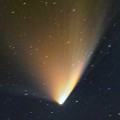
|
It passed the perihelion on Mar. 10, and brightened up to 0-1 mag. Now it is fading. But it is still bright as 6.6 mag (Apr. 19, Yoshimi Nagai). In the Northern Hemisphere, it will be observable all night after May. It is not observable in the Southern Hemisphere for a while after this.
Date(TT) R.A. (2000) Decl. Delta r Elong. m1 Best Time(A, h)
Apr. 20 0 21.70 57 15.4 1.433 1.083 48 6.0 3:52 (216, 24)
Apr. 27 0 16.04 63 42.0 1.493 1.219 54 6.5 3:41 (211, 29)
|
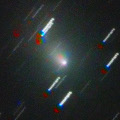
|
Now it is so bright as 10.8 mag (Mar. 29, Marco Goiato). It will be unobservable soon in the Northern Hemisphere. In the Southern Hemisphere, it keeps observable for a long time until the comet fades out, although it keeps locating low.
Date(TT) R.A. (2000) Decl. Delta r Elong. m1 Best Time(A, h)
Apr. 20 4 34.44 14 17.7 2.163 1.533 39 12.0 20:06 ( 97, 15)
Apr. 27 4 48.78 11 37.7 2.198 1.518 36 12.0 20:14 ( 98, 9)
|
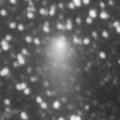
|
Now it is bright as 12.4 mag (Apr. 13, Sandor Szabo). It keeps observable at 11-13 mag for a long time from 2012 summer to 2013 summer.
Date(TT) R.A. (2000) Decl. Delta r Elong. m1 Best Time(A, h)
Apr. 20 14 45.48 4 50.9 1.996 2.955 158 12.7 0:55 ( 0, 60)
Apr. 27 14 31.10 8 8.3 2.053 3.009 157 12.8 0:13 ( 0, 63)
|

|
It brightened up to 11-12 mag in 2012. Now it is 12.8 mag (Apr. 13, Sandor Szabo). It will be observable at 12-13 mag in good condition again in 2013.
Date(TT) R.A. (2000) Decl. Delta r Elong. m1 Best Time(A, h)
Apr. 20 14 27.53 -14 47.4 4.839 5.832 170 12.8 0:37 ( 0, 40)
Apr. 27 14 18.80 -14 16.2 4.850 5.857 179 12.8 0:00 ( 0, 41)
|
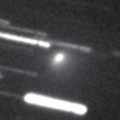
|
Now it is bright as 12.0 mag (Apr. 15, Artyom Novichonok). It keeps locating in the morning sky for a long time after this. I will keep the current brightness for a long time.
Date(TT) R.A. (2000) Decl. Delta r Elong. m1 Best Time(A, h)
Apr. 20 22 38.20 5 13.0 2.011 1.535 48 12.9 3:52 (275, 17)
Apr. 27 22 56.76 6 25.7 2.024 1.576 49 13.0 3:41 (274, 17)
|

|
It brightened rapidly, and reached up to 12 mag in 2012. It is bright as 12.2 mag still now (Mar. 23, Marco Goiato). It keeps 12-14 mag until autumn. It locates somewhat low in the Northern Hemisphere.
Date(TT) R.A. (2000) Decl. Delta r Elong. m1 Best Time(A, h)
Apr. 20 19 42.33 -25 51.9 2.616 2.913 96 13.2 3:52 (331, 23)
Apr. 27 19 47.91 -26 17.4 2.530 2.919 102 13.1 3:41 (334, 24)
|
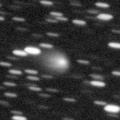
|
Now it is 14.1 mag (Apr. 3, Toshiyuki Takahashi). It keeps bright at 13-14 mag for a long time until 2014. It keeps observable for a long time in the Northern Hemisphere. It became observable also in the Southern Hemisphere.
Date(TT) R.A. (2000) Decl. Delta r Elong. m1 Best Time(A, h)
Apr. 20 21 19.90 31 12.2 6.254 5.904 65 13.5 3:52 (259, 45)
Apr. 27 21 19.19 31 33.7 6.173 5.902 69 13.5 3:41 (260, 49)
|

|
Now it is faint, but visible visually at 14.3 mag (Apr. 16, Alan Hale).
Date(TT) R.A. (2000) Decl. Delta r Elong. m1 Best Time(A, h)
Apr. 20 13 54.18 -23 30.1 5.235 6.221 167 13.5 0:03 ( 0, 31)
Apr. 27 13 50.93 -23 14.3 5.230 6.220 168 13.5 23:28 ( 0, 32)
|

|
It keeps 13 mag and observable in good condition in the Northern Hemisphere for a long time from 2013 to 2014. Now it is 14.5 mag (Mar. 4, Sandor Szabo). It locates extremely low in the Southern Hemisphere.
Date(TT) R.A. (2000) Decl. Delta r Elong. m1 Best Time(A, h)
Apr. 20 9 16.64 49 59.1 3.925 4.126 94 14.1 20:06 (155, 73)
Apr. 27 9 10.50 50 9.9 4.007 4.092 87 14.1 20:14 (141, 68)
|
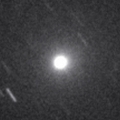
|
Now it is so bright as 11.6 mag (Apr. 2, Carlos Labordena). It will be fading gradually after this.
Date(TT) R.A. (2000) Decl. Delta r Elong. m1 Best Time(A, h)
Apr. 20 9 48.11 16 50.2 1.320 1.953 113 14.3 20:06 ( 9, 71)
Apr. 27 9 53.84 14 32.7 1.384 1.957 108 14.5 20:14 ( 27, 67)
|

|
It brightened up to 9.0 mag in 2012 autumn (Nov. 4, Juan Jose Gonzalez). However, it faded out unexpectedly around the perihelion passage. It was expected to be 9-10 mag, but actually, it is much fainter as 13.8 mag (Apr. 16, Artyom Novichonok). In the Southern Hemisphere, it keeps observable in good condition while fading slowly after this. In the Northern Hemisphere, it is hardly observable after 2013.
Date(TT) R.A. (2000) Decl. Delta r Elong. m1 Best Time(A, h)
Apr. 20 0 13.26 -43 7.4 2.567 2.222 58 14.4 3:52 (305,-28)
Apr. 27 0 35.58 -42 59.8 2.575 2.272 61 14.5 3:41 (304,-29)
|
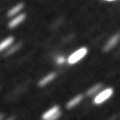
|
Now it is 14.4 mag (Apr. 13, Sandor Szabo). It will brighten up to 12 mag from summer to autumn. In the Northern Hemisphere, it will be unobservable in late April. In the Southern Hemisphere, it keeps unobservable until August. Then it keeps observable while fading gradually.
Date(TT) R.A. (2000) Decl. Delta r Elong. m1 Best Time(A, h)
Apr. 20 3 3.58 39 57.3 2.953 2.176 32 14.7 20:06 (130, 13)
Apr. 27 3 20.91 38 44.6 2.938 2.110 28 14.6 20:14 (131, 9)
|

|
Now it is 15.3 mag (Apr. 13, Sandor Szabo). It keeps bright as 13-14 mag for a long time from 2013 to 2014.
Date(TT) R.A. (2000) Decl. Delta r Elong. m1 Best Time(A, h)
Apr. 20 14 36.73 -10 32.3 2.465 3.456 168 14.7 0:46 ( 0, 44)
Apr. 27 14 31.90 -10 21.3 2.438 3.442 175 14.6 0:13 ( 0, 45)
|

|
Big asteroid discovered in 1906. It suddenly showed the cometary activity on Dec. 11, 2010, probably due to an impact of a small object. It has already turned to be stellar. Appearing in the morning sky again in the Southern Hemisphere.
Date(TT) R.A. (2000) Decl. Delta r Elong. m1 Best Time(A, h)
Apr. 20 23 26.46 -16 29.6 3.418 2.805 45 14.6 3:52 (286, -6)
Apr. 27 23 36.65 -15 43.8 3.365 2.817 49 14.6 3:41 (286, -4)
|

|
Now it is 15.5 mag (Apr. 13, Ken-ichi Kadota). It is expected to be a great comet in 2013 autumn when the comet approaches to the sun down to only 0.01 A.U. It keeps visible with naked eyes from November to January, and can be extremely bright as Venus or more at the highlight. It became unobservable in late May. The condition is excellent in the Northern Hemisphere. It will appear in the morning sky again in late August, then it keeps observable almost all through the period of brightening, at the highlight, and of fading. The condition is not good in the Southern Hemisphere. It is not observable at all the latter part of the highlight, and it keeps low all through the period.
Date(TT) R.A. (2000) Decl. Delta r Elong. m1 Best Time(A, h)
Apr. 20 6 38.45 29 52.4 4.287 4.031 68 14.7 20:06 ( 98, 48)
Apr. 27 6 40.29 29 36.5 4.312 3.946 62 14.6 20:14 (101, 41)
|

|
It brightens up to 10 mag in summer. But the condition is worst and the comet will be hardly observable in this apparition. In the Northern Hemisphere, it will be observable in autumn when the comet will be fainter than 16 mag.
Date(TT) R.A. (2000) Decl. Delta r Elong. m1 Best Time(A, h)
Apr. 20 1 6.10 -0 32.7 2.414 1.477 16 15.3 3:52 (258,-17)
Apr. 27 1 26.61 1 47.4 2.349 1.420 17 14.8 3:41 (256,-16)
|

|
It kept as bright as 6-7 mag for a long time from 2011 summer to 2012 spring. Now it is fading. But it is bright as 15.2 mag still now (Mar. 4, Sandor Szabo).
Date(TT) R.A. (2000) Decl. Delta r Elong. m1 Best Time(A, h)
Apr. 20 8 8.65 -7 46.1 5.443 5.633 95 14.8 20:06 ( 37, 40)
Apr. 27 8 8.37 -7 32.1 5.612 5.694 89 14.9 20:14 ( 47, 35)
|
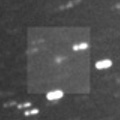
|
Now it is 15.2 mag (Mar. 30, J. F. Hernandez). It reaches up to 15 mag from spring to summer. It is observable in excellent condition in the Southern Hemisphere. It locates low in the Northern Hemisphere.
Date(TT) R.A. (2000) Decl. Delta r Elong. m1 Best Time(A, h)
Apr. 20 14 59.15 -44 52.6 2.505 3.366 143 14.9 1:09 ( 0, 10)
Apr. 27 14 38.63 -42 39.8 2.447 3.361 150 14.8 0:21 ( 0, 12)
|

|
Now it is 14.1 mag (Mar. 5, Hidetaka Sato). It will be fading slowly after this. But it keeps 15 mag in 2013. It becomes temporarily low in May, but will be observable in good condition again after June in the Southern Hemisphere. It is not observable now in the Northern Hemisphere.
Date(TT) R.A. (2000) Decl. Delta r Elong. m1 Best Time(A, h)
Apr. 20 3 22.97 -29 6.9 7.108 6.453 46 14.9 20:06 ( 70,-23)
Apr. 27 3 26.89 -28 14.2 7.149 6.480 45 14.9 20:14 ( 74,-29)
|
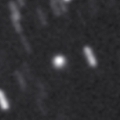
|
Now it is 15.5 mag (Apr. 20, Taras Prystavski). It is expected to brighten up to 5-6 mag in 2014 autumn. In 2013, it keeps observable in good condition until autumn when it brigthens up to 13-14 mag.
Date(TT) R.A. (2000) Decl. Delta r Elong. m1 Best Time(A, h)
Apr. 20 17 21.84 17 1.4 5.430 6.006 120 15.5 3:30 ( 0, 72)
Apr. 27 17 17.43 17 51.5 5.301 5.942 125 15.4 2:58 ( 0, 73)
|

|
It reached up to 12 mag from autumn to winter in 2012. Now it is not observable. But it will appear in the morning sky in July. Then it will be observable at 17 mag in good condition in autumn.
Date(TT) R.A. (2000) Decl. Delta r Elong. m1 Best Time(A, h)
Apr. 20 3 4.63 17 54.6 4.346 3.411 18 15.4 20:06 (112, -1)
Apr. 27 3 15.40 17 56.9 4.401 3.436 14 15.5 20:14 (116, -5)
|

|
Now it is bright as 14.7 mag (Apr. 13, Sandor Szabo). It will be observable at 15-16 mag for a long time from 2013 to 2014.
Date(TT) R.A. (2000) Decl. Delta r Elong. m1 Best Time(A, h)
Apr. 20 11 51.86 6 37.8 2.994 3.862 145 16.0 21:57 ( 0, 62)
Apr. 27 11 49.69 6 35.0 3.049 3.857 138 16.0 21:27 ( 0, 62)
|
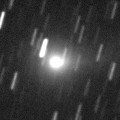
|
Long-lost comet for almost 200 years since 1827. Finally re-discovered by Rob Matson from SWAN images of mid November. Now it is fading, but still bright as 13.5 mag (Apr. 13, Sandor Szabo). In the Northern Hemisphere, it keeps observable in excellent condition while fading after this. In the Southern Hemisphere, it keeps locating extremely low after this.
Date(TT) R.A. (2000) Decl. Delta r Elong. m1 Best Time(A, h)
Apr. 20 12 48.84 53 27.7 1.534 2.146 113 16.0 22:50 (180, 72)
Apr. 27 12 13.29 51 10.4 1.686 2.235 109 16.6 21:49 (180, 74)
|

|
Now it is unusually bright in outburst. It was faint as 18.5 mag on Apr. 10, but brightened up to 16.1 mag on Apr. 16 (Hidetaka Sato).
Date(TT) R.A. (2000) Decl. Delta r Elong. m1 Best Time(A, h)
Apr. 20 22 40.62 -23 5.4 1.252 1.116 58 16.1 3:52 (298, -1)
Apr. 27 23 9.03 -22 41.5 1.279 1.147 58 16.4 3:41 (296, -3)
|

|
Now it is 16.1 mag (Mar. 4, Hidetaka Sato). In the Southern Hemisphere, it will be observable at 15-16 mag in good condition for a long time until summer. It is not observable at all in the Northern Hemisphere.
Date(TT) R.A. (2000) Decl. Delta r Elong. m1 Best Time(A, h)
Apr. 20 3 25.39 -50 8.9 4.754 4.423 64 16.3 20:06 ( 48,-31)
Apr. 27 3 36.56 -48 49.6 4.783 4.452 64 16.4 20:14 ( 51,-35)
|

|
Now it is 17.2 mag (Apr. 11, Hidetaka Sato). It keeps 16 mag and observable in good condition until July.
Date(TT) R.A. (2000) Decl. Delta r Elong. m1 Best Time(A, h)
Apr. 20 19 32.98 -16 28.4 1.928 2.288 97 16.5 3:52 (329, 32)
Apr. 27 19 30.16 -12 40.7 1.807 2.275 104 16.4 3:41 (332, 38)
|
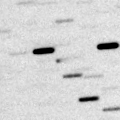
|
Now it is 16.6 mag (Apr. 2, Hidetaka Sato). It keeps observable at 16 mag in the morning sky from February to April.
Date(TT) R.A. (2000) Decl. Delta r Elong. m1 Best Time(A, h)
Apr. 20 21 1.08 -8 11.3 1.591 1.643 74 16.4 3:52 (303, 27)
Apr. 27 21 15.61 -7 13.2 1.561 1.669 77 16.6 3:41 (303, 28)
|
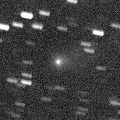
|
It brightened up to 15.5 mag in 2012 summer. Although it has already passed the perihelion, it tends to become brightest after the perihelion passage. It will be observabel at 16 mag again in 2013 summer. Now it is 18.1 mag, fainter than this ephemeris (Apr. 11, Hidetaka Sato).
Date(TT) R.A. (2000) Decl. Delta r Elong. m1 Best Time(A, h)
Apr. 20 21 56.86 -18 27.2 3.756 3.455 65 16.5 3:52 (301, 10)
Apr. 27 22 4.03 -18 7.9 3.680 3.470 70 16.4 3:41 (302, 12)
|
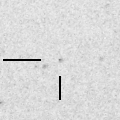
|
Now it is 17.5 mag (Mar. 16, Hidetaka Sato). It keeps observable in good condition at 17 mag from spring to summer.
Date(TT) R.A. (2000) Decl. Delta r Elong. m1 Best Time(A, h)
Apr. 20 18 45.64 -12 46.6 2.421 2.898 108 16.7 3:52 (340, 40)
Apr. 27 18 49.23 -11 53.6 2.341 2.900 113 16.6 3:41 (344, 42)
|
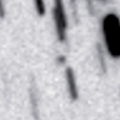
|
Now it is 17.9 mag (Apr. 4, Toshiyuki Takahashi). It is expected to brighten up to 14 mag in July and August. In the Southern Hemisphere, it keeps observable for a long time until the comet fades out. It keeps observable in good condition until September also in the Northern Hemisphere.
Date(TT) R.A. (2000) Decl. Delta r Elong. m1 Best Time(A, h)
Apr. 20 22 1.12 23 19.7 3.179 2.744 55 16.9 3:52 (263, 34)
Apr. 27 22 3.85 23 4.9 3.054 2.704 60 16.7 3:41 (265, 36)
|
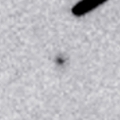
|
It is expected to brighten up to 11 mag and become observable in excellent condition in 2014 spring. Now it is 16.8 mag (Apr. 17, A. Klotz, F. Kugel, J. Caron). In the Northern Hemisphere, it keeps observable in good condition until early summer. It locates low in the Southern Hemisphere.
Date(TT) R.A. (2000) Decl. Delta r Elong. m1 Best Time(A, h)
Apr. 20 8 32.88 40 50.7 3.866 3.999 90 17.0 20:06 (115, 72)
Apr. 27 8 34.60 40 40.8 3.905 3.933 84 16.9 20:14 (112, 66)
|

|
Now it is 18.3 mag (Apr. 11, Hidetaka Sato). It is expected to be observable at 16 mag in good condition in summer and autumn. But it is fainter than predicted recently.
Date(TT) R.A. (2000) Decl. Delta r Elong. m1 Best Time(A, h)
Apr. 20 21 57.65 5 38.5 2.516 2.158 57 17.1 3:52 (281, 25)
Apr. 27 22 10.80 7 9.2 2.452 2.150 60 17.1 3:41 (280, 27)
|

|
New comet. Now it is 16.7 mag (Apr. 8, Siding Spring Survey). It will be fading after this. It locates low in the Northern Hempshere.
Date(TT) R.A. (2000) Decl. Delta r Elong. m1 Best Time(A, h)
Apr. 20 20 19.33 -36 0.5 2.437 2.654 91 17.2 3:52 (329, 10)
Apr. 27 20 12.71 -34 50.6 2.357 2.700 98 17.2 3:41 (333, 14)
|
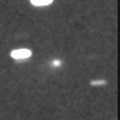
|
Now it is bright as 15.8 mag (Apr. 10, Catalina Sky Survey). It keeps observable in good condition at 16-17 mag until June. It locates somewhat low in the Southern Hemisphere.
Date(TT) R.A. (2000) Decl. Delta r Elong. m1 Best Time(A, h)
Apr. 20 9 17.99 21 28.3 1.444 1.965 105 17.2 20:06 ( 37, 74)
Apr. 27 9 26.93 20 52.1 1.503 1.958 100 17.3 20:14 ( 51, 69)
|

|
First return of a new periodic comet discovered in 2005. It will be observable at 17 mag for a long time from 2013 to 2014. However, it has not been recovered yet. Not it is fainter than 19.5 mag (Feb. 21, Martin Masek).
Date(TT) R.A. (2000) Decl. Delta r Elong. m1 Best Time(A, h)
Apr. 20 17 23.80 -13 47.8 2.581 3.298 128 17.4 3:32 ( 0, 41)
Apr. 27 17 23.12 -13 34.7 2.500 3.290 134 17.3 3:04 ( 0, 41)
|

|
It was observed around 20 mag in 2012 spring. But it has not been observed recently. It will be observable at 17.5 mag from spring to summer.
Date(TT) R.A. (2000) Decl. Delta r Elong. m1 Best Time(A, h)
Apr. 20 18 25.75 -20 50.4 2.062 2.634 113 17.5 3:52 (348, 33)
Apr. 27 18 28.47 -20 7.3 1.988 2.639 119 17.4 3:41 (352, 34)
|
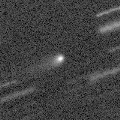
|
Now it is 17.4 mag (Apr. 17, M. Brusa, L. Sempio). It brightened up to 16.5 mag in 2012. It will be observable in good condition again at 17.5 mag in 2013 spring.
Date(TT) R.A. (2000) Decl. Delta r Elong. m1 Best Time(A, h)
Apr. 20 13 1.73 8 55.7 5.190 6.122 156 17.4 23:06 ( 0, 64)
Apr. 27 12 54.15 9 19.0 5.258 6.142 149 17.5 22:31 ( 0, 64)
|

|
New comet. Now it is 18.1 mag (Apr. 20, P. C. Sherrod). It brightens up to 17.5 mag in May and June.
Date(TT) R.A. (2000) Decl. Delta r Elong. m1 Best Time(A, h)
Apr. 20 16 0.72 -12 19.7 1.431 2.346 148 18.0 2:10 ( 0, 43)
Apr. 27 15 30.96 -14 0.7 1.329 2.307 162 17.7 1:13 ( 0, 41)
|

|
New comet. Now it is 17.8 mag (Apr. 21, Catalina Sky Survey). It brightens up to 18 mag at best in May and June.
Date(TT) R.A. (2000) Decl. Delta r Elong. m1 Best Time(A, h)
Apr. 20 15 8.12 16 57.9 1.769 2.660 145 18.0 1:17 ( 0, 72)
Apr. 27 15 4.45 16 26.1 1.743 2.649 147 17.9 0:46 ( 0, 71)
|

|
It was predicted to be already 16-17 mag. But actually, it is 19.8 mag, much fainter than predicted by 4 mag (Apr. 3, Jean-Francois Soulier). It was expected to brighten up to 14 mag and to be observable in excellent condition in summer. However, it can be fainter than 18 mag.
Date(TT) R.A. (2000) Decl. Delta r Elong. m1 Best Time(A, h)
Apr. 20 15 21.26 2 23.9 1.019 1.971 153 19.9 1:30 ( 0, 57)
Apr. 27 15 18.78 3 0.5 0.969 1.937 157 19.7 1:00 ( 0, 58)
|
|
![]()
 C/2009 P1 ( Garradd )
C/2009 P1 ( Garradd ) C/2012 K6 ( McNaught )
C/2012 K6 ( McNaught ) C/2009 F4 ( McNaught )
C/2009 F4 ( McNaught ) C/2012 K1 ( PanSTARRS )
C/2012 K1 ( PanSTARRS ) C/2012 J1 ( Catalina )
C/2012 J1 ( Catalina ) P/2012 B1 ( PanSTARRS )
P/2012 B1 ( PanSTARRS ) 273P/2012 V4 ( Pons-Gambart )
273P/2012 V4 ( Pons-Gambart ) 197P/LINEAR
197P/LINEAR C/2011 O1 ( LINEAR )
C/2011 O1 ( LINEAR ) C/2013 F3 ( McNaught )
C/2013 F3 ( McNaught ) 125P/Spacewatch
125P/Spacewatch 152P/Helin-Lawrence
152P/Helin-Lawrence P/2012 F2 ( PanSTARRS )
P/2012 F2 ( PanSTARRS ) C/2012 S3 ( PanSTARRS )
C/2012 S3 ( PanSTARRS ) C/2012 X1 ( LINEAR )
C/2012 X1 ( LINEAR ) 257P/2012 F4 ( Catalina )
257P/2012 F4 ( Catalina ) C/2013 G2 ( McNaught )
C/2013 G2 ( McNaught ) 175P/Hergenrother
175P/Hergenrother P/2005 L1 ( McNaught )
P/2005 L1 ( McNaught ) 91P/Russell 3
91P/Russell 3 C/2010 R1 ( LINEAR )
C/2010 R1 ( LINEAR ) C/2013 G6 ( Lemmon )
C/2013 G6 ( Lemmon ) C/2013 H1 ( La Sagra )
C/2013 H1 ( La Sagra ) 98P/Takamizawa
98P/Takamizawa![]()

































